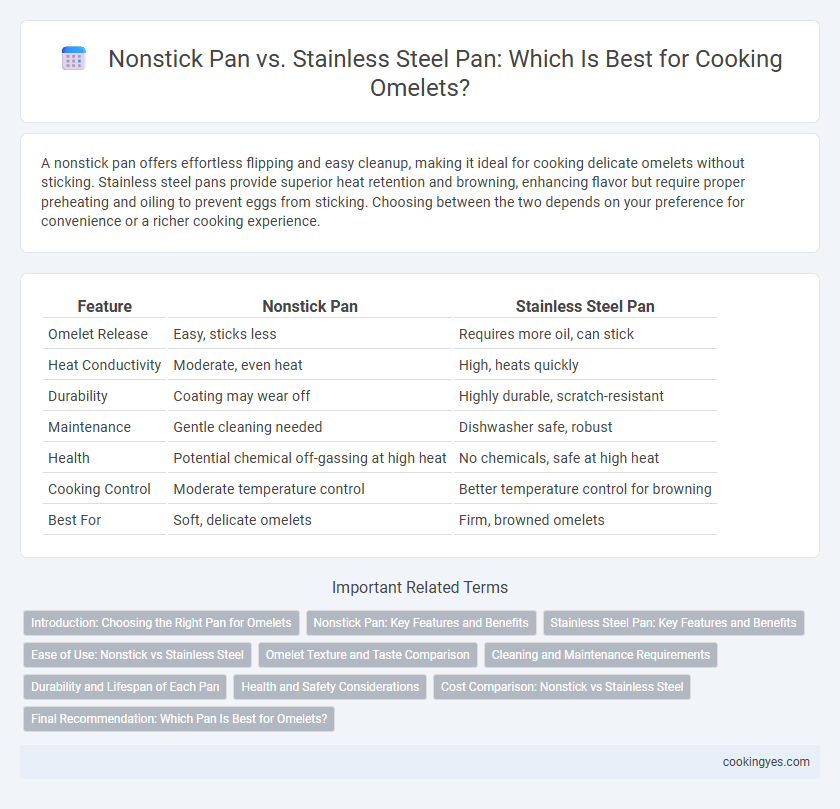A nonstick pan offers effortless flipping and easy cleanup, making it ideal for cooking delicate omelets without sticking. Stainless steel pans provide superior heat retention and browning, enhancing flavor but require proper preheating and oiling to prevent eggs from sticking. Choosing between the two depends on your preference for convenience or a richer cooking experience.
Table of Comparison
| Feature | Nonstick Pan | Stainless Steel Pan |
|---|---|---|
| Omelet Release | Easy, sticks less | Requires more oil, can stick |
| Heat Conductivity | Moderate, even heat | High, heats quickly |
| Durability | Coating may wear off | Highly durable, scratch-resistant |
| Maintenance | Gentle cleaning needed | Dishwasher safe, robust |
| Health | Potential chemical off-gassing at high heat | No chemicals, safe at high heat |
| Cooking Control | Moderate temperature control | Better temperature control for browning |
| Best For | Soft, delicate omelets | Firm, browned omelets |
Introduction: Choosing the Right Pan for Omelets
Selecting the optimal pan for cooking omelets significantly impacts texture and ease of preparation. Nonstick pans offer superior food release and minimal oil requirements, ideal for tender, evenly cooked omelets. Stainless steel pans provide excellent heat retention and durability but usually require more skill and oil to prevent sticking during omelet cooking.
Nonstick Pan: Key Features and Benefits
Nonstick pans offer superior ease in cooking omelets by preventing sticking, which ensures smooth flipping and perfect folding without breaking. The nonstick coating significantly reduces the need for oil or butter, promoting healthier, lower-fat meals. Their quick and even heat distribution enhances cooking efficiency, making them ideal for delicate omelets that require gentle heat control.
Stainless Steel Pan: Key Features and Benefits
Stainless steel pans offer superior heat retention and even cooking, making them ideal for achieving a perfectly browned and evenly cooked omelet. Their durable, non-reactive surface resists scratching and warping, ensuring long-term usability and maintaining food flavor without metallic tastes. Unlike nonstick pans, stainless steel allows for precise temperature control and can withstand higher heat, enhancing the texture and caramelization of eggs.
Ease of Use: Nonstick vs Stainless Steel
Nonstick pans offer superior ease of use for cooking omelets due to their smooth, coated surfaces that prevent sticking and require less oil or butter. Stainless steel pans demand more skill and attention to heat control to avoid sticking, often needing preheating and proper seasoning before cooking. Nonstick cookware simplifies omelet flipping and cleanup, making it ideal for beginners and quick meal preparation.
Omelet Texture and Taste Comparison
Nonstick pans create a soft, tender omelet texture due to even heat distribution and minimal sticking, preserving the eggs' delicate structure. Stainless steel pans often produce a slightly firmer, browner exterior with a richer, caramelized flavor that enhances the omelet's taste profile. Texture preferences vary: nonstick favours smoothness and ease, while stainless steel delivers a more complex, robust omelet experience.
Cleaning and Maintenance Requirements
Nonstick pans offer easy cleaning due to their smooth, coated surface that prevents eggs from sticking, requiring only gentle hand washing to maintain the coating's integrity. Stainless steel pans demand more rigorous cleaning efforts, often involving scrubbing to remove food residues and occasional use of stainless steel cleaners to prevent discoloration and maintain shine. Proper maintenance of nonstick pans includes avoiding metal utensils and high heat, while stainless steel pans benefit from seasoning and thorough drying to prevent rust and prolong usability.
Durability and Lifespan of Each Pan
Nonstick pans offer excellent omelet release but tend to have a shorter lifespan, typically lasting around 3 to 5 years due to coating degradation from high heat and abrasive utensils. Stainless steel pans, while requiring more skill to prevent sticking, boast superior durability and can last decades without compromising performance when properly maintained. Choosing between these materials depends on balancing the ease of omelet cooking with long-term investment in cookware longevity.
Health and Safety Considerations
Nonstick pans offer a safer cooking surface for omelets by reducing the need for excessive oils and preventing food from sticking, but concerns about chemical coatings such as PFOA and PTFE under high heat persist. Stainless steel pans are free from synthetic coatings, eliminating the risk of toxic fumes, but they require careful temperature control and sufficient oil to avoid food sticking and uneven cooking. Choosing between these options depends on balancing the benefits of lower fat cooking with nonstick surfaces against the durability and chemical-free nature of stainless steel cookware.
Cost Comparison: Nonstick vs Stainless Steel
Nonstick pans typically cost between $20 to $50, making them more affordable for casual omelet cooking, while stainless steel pans range from $40 to $150, reflecting their durability and versatility. Despite higher upfront costs, stainless steel pans offer long-term value due to their resistance to scratches and ability to withstand higher heat. Nonstick surfaces may require replacement every few years, increasing overall expenses compared to the more robust lifespan of stainless steel cookware.
Final Recommendation: Which Pan Is Best for Omelets?
Nonstick pans offer superior ease of use with effortless release and minimal oil needed, making them ideal for perfectly fluffy, evenly cooked omelets. Stainless steel pans provide excellent heat retention and browning, delivering a more flavorful and textured omelet but require precise temperature control and proper seasoning to prevent sticking. For consistently tender, hassle-free omelets, a high-quality nonstick pan is generally the best choice.
Nonstick Pan vs Stainless Steel Pan for Omelet Cooking Infographic

 cookingyes.com
cookingyes.com